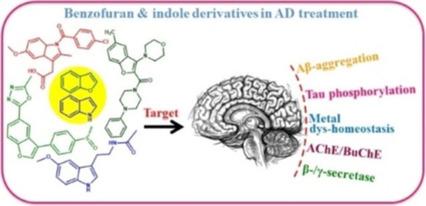当前位置:
X-MOL 学术
›
ChemMedChem
›
论文详情
Our official English website, www.x-mol.net, welcomes your
feedback! (Note: you will need to create a separate account there.)
Benzofuran and Indole: Promising Scaffolds for Drug Development in Alzheimer's Disease
ChemMedChem ( IF 3.6 ) Pub Date : 2018-06-19 , DOI: 10.1002/cmdc.201800156 Deepti Goyal 1 , Amandeep Kaur 1 , Bhupesh Goyal 2
ChemMedChem ( IF 3.6 ) Pub Date : 2018-06-19 , DOI: 10.1002/cmdc.201800156 Deepti Goyal 1 , Amandeep Kaur 1 , Bhupesh Goyal 2
Affiliation

|
Alzheimer's disease (AD) is a progressive neurodegenerative disease with no clinically accepted treatment to cure or halt its progression. The Food and Drug Administration has approved drugs (e.g., rivastigmine, donepezil, galantamine, and memantine) that at best provide marginal benefits, thus emphasizing the urgent need to explore other molecular entities as future drug candidates for AD. Looking at the wide pharmaceutical applications of heterocyclic compounds and particularly those containing benzofuran and indole ring systems, these molecular frameworks have drawn special attention from medicinal chemists for further evaluation in numerous diseases. This article focuses on the history and recent advances of benzofuran‐ and indole‐based compounds as inhibitors of butyrylcholinesterase, acetylcholinesterase, γ‐secretase, β‐secretase, tau misfolding, and β‐amyloid aggregation.
中文翻译:

苯并呋喃和吲哚:阿尔茨海默氏病药物开发的有希望的支架
阿尔茨海默氏病(AD)是一种进行性神经退行性疾病,没有临床公认的治疗方法来治愈或阻止其进展。美国食品药品监督管理局(FDA)已批准最多可带来边际效益的药物(例如,卡巴拉汀,多奈哌齐,加兰他敏和美金刚),从而强调了迫切需要探索其他分子实体作为AD的未来候选药物。鉴于杂环化合物,特别是含有苯并呋喃和吲哚环系统的杂环化合物在医药领域的广泛应用,这些分子框架引起了药物化学家的特别关注,可用于进一步评估多种疾病。本文着眼于苯并呋喃和吲哚类化合物作为丁酰胆碱酯酶,乙酰胆碱酯酶,γ-分泌酶,β-分泌酶抑制剂的历史和最新进展。
更新日期:2018-06-19
中文翻译:

苯并呋喃和吲哚:阿尔茨海默氏病药物开发的有希望的支架
阿尔茨海默氏病(AD)是一种进行性神经退行性疾病,没有临床公认的治疗方法来治愈或阻止其进展。美国食品药品监督管理局(FDA)已批准最多可带来边际效益的药物(例如,卡巴拉汀,多奈哌齐,加兰他敏和美金刚),从而强调了迫切需要探索其他分子实体作为AD的未来候选药物。鉴于杂环化合物,特别是含有苯并呋喃和吲哚环系统的杂环化合物在医药领域的广泛应用,这些分子框架引起了药物化学家的特别关注,可用于进一步评估多种疾病。本文着眼于苯并呋喃和吲哚类化合物作为丁酰胆碱酯酶,乙酰胆碱酯酶,γ-分泌酶,β-分泌酶抑制剂的历史和最新进展。











































 京公网安备 11010802027423号
京公网安备 11010802027423号